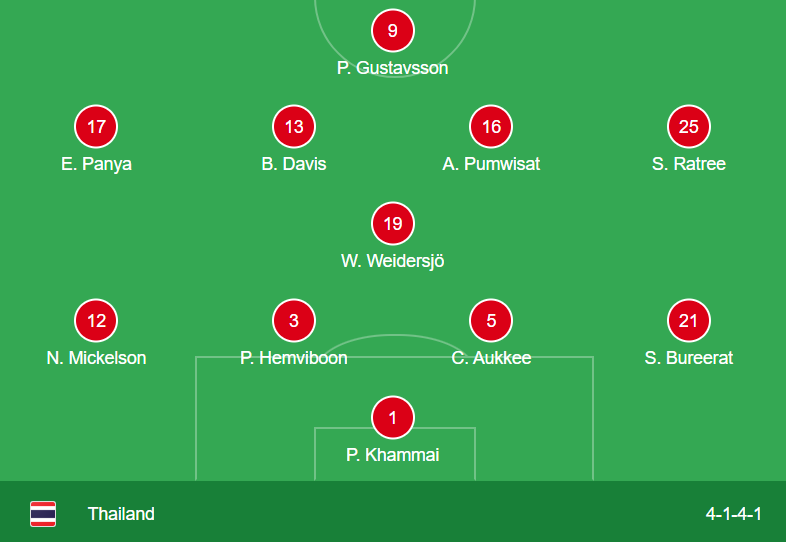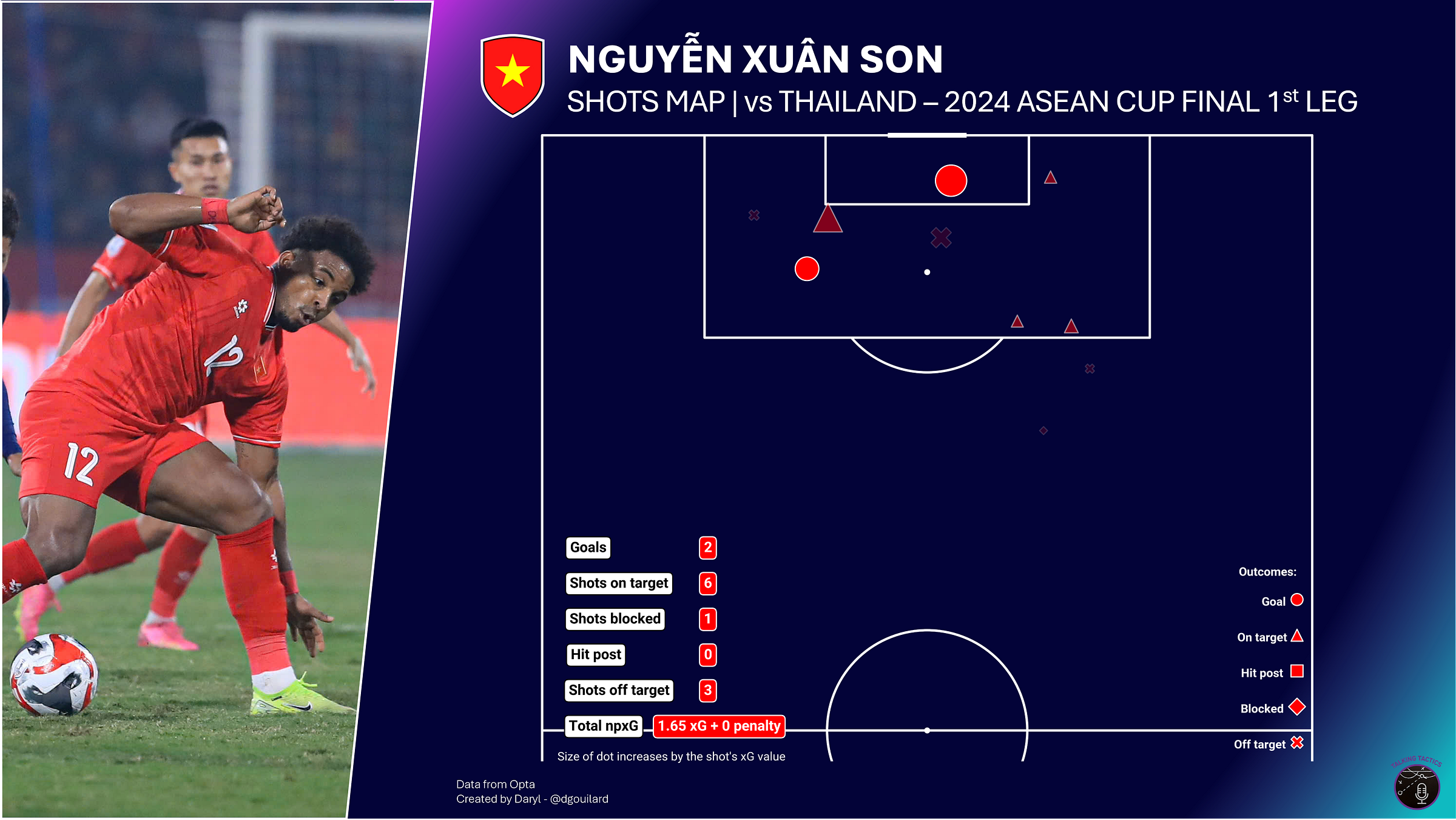ASEAN Cup Diary: Final 1st leg
After two weeks, two best teams in Southeast Asia will battle it out for the trophy, regional pride, and social media bragging rights.
After fighting off challenges from other teams in the region, it all comes down to this. The ASEAN Cup final, and it will be a competition between the two best teams from Southeast Asia in Thailand and Vietnam. It has been a final with a lot of historic values and rivalries in it because both teams have played each other multiple times in past tournaments, and there were also a lot of iconic moments made a long the way. For the 2024-25 edition, whose name will be etched into the history book? Let us find out!
Lineup
For the home team, Vietnam, they lined up in a 3-4-3 formation (ignore the 3-5-2 one that Google have here, most of the time they are incorrect about positions and formations for Vietnamese teams) with the front three that started against Singapore that consisted of striker (#12) Nguyễn Xuân Son/Rafaelson being supported by two attacking midfielders (#15) Bùi Vĩ Hào and (#8) Châu Ngọc Quang. This was a surprising choice for me because even though Vĩ Hào had some decent performances here and there, both attacking midfielders have not been able to connect with Rafaelson well up top and converted the chances created for them by the Brazilian-born striker. Meanwhile, goalkeeper (#21) Nguyễn Đình Triệu continued to start in goal at the expense of (#1) Filip Nguyễn, who was thought to be the starting keeper for Vietnam throughout this tournament.
For Thailand, this seemed like almost their strongest lineup with a lot of players who performed well against the Philippines retaining their spot in the lineup. At the back would be the Thai-born pairing at the heart of the defence with centre-backs (#3) Pansa Hemviboon and (#5) Chalermsak Aukkee being supported by right-back (#21) Suphanan Bureerat and Danish-born left-back (#12) Nicholas Mickelson. The most interesting players, for me, in this lineup, was (#17) Ekanit Panya making his debut in this year’s tournament while (#13) Ben Davis and (#25) Seksan Ratree retained their spot as the attacking midfielders at the expense of two key players (#7) Supachok Sarachat and (#10) Suphanat Mueanta.
First half
Right off the bat, I was proven wrong for saying Vietnam would play with a 3-4-3 instead of a 3-5-2. Out of possession, they pressed Thailand in a 5-3-1-1 mid block where striker Xuân Son took on the responsibility of pressing Thailand’s centre-backs while attacking midfielder Ngọc Quang man-marked Thailand’s defensive midfielder (#19) William Weidersjö out of the away side’s build-up phase. By the first few pressing attempts, that strategy seemed to be working with Thailand being forced to concede three high turnovers within the first ten minutes.

While Vietnam had created a few chances from counter-attacking situations, Thailand also had a few themselves coming from settled possessions where they exploited the left-hand side. The presences of Mickelson and Ekanit on the left were crucial because Mickelson was competent with making overlapping runs to challenge Vĩ Hào, who did not look comfortable in a more defensive role, and Ekanit’s positioning to receive the ball in between the lines dragged some of Vietnam’s defenders out of the way for other teammates like Weidersjö to get into the box. So far, though, both teams’ chances have not proven to be threatening that much.
Going back to Vietnam’s out of possession shape a bit because I wanted to quickly discuss about the personnel choice to use Vĩ Hào and Ngọc Quang instead of more experienced and better players like (#10) Phạm Tuấn Hải or (#19) Nguyễn Quang Hải. Offensively, they did not look that good for me as they sometimes dwelled on the ball for too long, which caused turnovers, or they ignored obvious passing options inside the box that would have increased the chance of scoring to take the chances by themselves.
But defensively, I think their work ethic impressed manager Kim Sang-sik as they were willing to run and work hard off the ball by running places to mark Thailand players or they were willing to move out of their respective positions to create overloads with the rest of the team. It was a tough dilemma, because offensively they did not offer much and basically left Xuân Son to do everything all by themselves, but defensively they helped the team. For a pragmatic and defensive-oriented coach like Kim, that probably got them the edge over better attacking players like Tuấn Hải, Quang Hải, or (#22) Nguyễn Tiến Linh. Okay, back to the match!
Thailand have continued to try and find the breakthrough down the left-hand side and now they also tried channel runs made by either Ekanit or striker (#9) Patrik Gustavsson. As I have mentioned in my Team of the Group stage piece, the Swedish-born striker had both the pace and quality to beat Vietnam defenders and brought the ball down from a lofted pass. The problem was, he constantly found himself isolated and alone when most of his teammates dropped deeper to help with ball progression. This meant that, similar to Xuân Son, he had to do everything all by himself and it resulted in him taking shots from locations that would not yield good goal-scoring probabilities.
Cagey half mostly, with challenges being thrown left and right and did not seem like there was a breakthrough in sight. Both teams defended well, but that could also be because neither of the teams have managed to create an attack that was actually dangerous towards each other’s goal. Maybe with a few substitutions and some tactical changes, things could change in the second half.
Second half
As expected, Vietnam made a change that I mentioned above when Quang Hải came on to fill in the attacking midfielder spot that Vĩ Hào occupied in the first half. This could be a crucial change because Vietnam’s #19 could create chances for Xuân Son and took that responsibility from him, which would allow him to focus more on just get into the right positions to score goals. Meanwhile, Thailand made two chances late into the first half and after half time where (#18) Weerathep Pomphan and (#6) Thitathorn Auksornsri came on for (#16) Akarapong Pumwisat at central midfielder and Mickelson at left-back respectively.
Weerathep was someone that I highlighted during Thailand’s second leg of the semi-final against the Philippines as he took on the #6 role in their 4-1-4-1 system and was the team’s ball-winning midfielder, and he was good at it. Him coming on could allow Weidersjö to move into a more advanced position where the Swedish-born midfielder could carry the ball and create chances for Gustavsson up top. On the other hand, bringing Thitathorn on for Mickelson looked more like a gamble from Masatada Ishii for me because even though Mickelson did not look that effective in the first half, his overlapping runs still provided a bit of values for Thailand’s attacks.
And Vietnam had only gone and found the opening goal after wasting a couple of decent chances. From a corner, Thailand was not able to clear the ball properly and allowed the host to bring the second ball down and, subsequently, allowed one of Vietnam’s players to deliver a cross towards the back post. There were centre-back (#16) Nguyễn Thành Chung and right wing-back (#17) Vũ Văn Thanh waiting, and it was Văn Thanh who got to the ball and headed into the 6-yard box for Xuân Son to score an easy tap-in header. 1-0, and I could only hope the game would start to open up a bit more from now.
The host have been hitting Thailand on the break on multiple occasions and, even though Thailand had 2 or 3 defenders for their rest defence, they still could not cope with the threat coming from Vietnam midfielders like Quang Hải and (#14) Nguyễn Hoàng Đức and striker Xuân Son up top. But, as decent as those counter-attacking chances were, they lacked the precision to beat Thailand keeper (#1) Patiwat Khammai and put the ball into the back of the net. Instead of the lead being more comfortable for Vietnam, this could come back and bite them now that Suphanat and Supachok have already came on for Thailand.
The absolute quality from Xuân Son, just wow. Both Pansa and Chalermsak were not easy centre-backs to deal with, yet his technical and dribbling abilities gave both centre-backs a tough time marking and tackling him. His second goal was a clear indication of that as he brought the ball down from a Vietnam’s counter-attack, dribbled on the outside of Pansa to prevent the Thai centre-back from making a tackle. Then, when he reached the box, he used his less preferred foot, which was his left, to make a shot towards the bottom right corner and away from Khammai’s reach. 2-0 for Vietnam after 75 minutes. Things could only get spicier from now on.
And I was not wrong! Thailand got one back just minutes after and it came from a similar situation to Vietnam’s first goal, where they got the second ball after a free-kick and brought it down for a cross. At that moment, inside of the box were centre-backs Pansa and Chalermsak along with striker Gustavsson, who were all aerially dominant compared to the Vietnamese defenders. Once the cross came in, it was more or less obvious that one of the three would get to the ball, and it was Chalermsak who pulled one back for his team with 10 minutes left plus stoppage time.
Wrapping up
Cagey match, but there were goals. And once again, Xuân Son’s quality guided Vietnam through a tough match as he remained the focal point of attack for the host and gave Thailand defenders a hard time to mark him. In terms of tactical aspect, there was not much since both teams matched each other well and most of the game was focused on the defensive side of things and it turned out to be an individual-reliant game more than anything tactical that stood out.
Nonetheless, Vietnam now hold a one-goal lead going into the second leg away from home. But Thailand have shown that never write them off given the quality that they have in their squad to turn things around. Especially when they are playing at home and under the encouragement of their home fans, Thailand have managed to turn things around before, which was against the Philippines to advance through to the final. So there are still a lot left to play in this final and the one-goal lead might not even make a difference. With that in mind, I will see you in two days with the coverage of the second leg!






